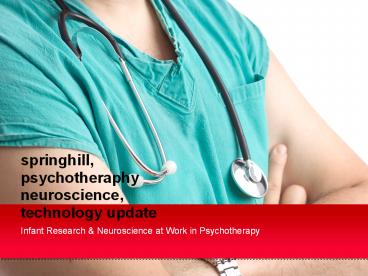Infant Research & Neuroscience at Work in Psychotherapy - PowerPoint PPT Presentation
Title:
Infant Research & Neuroscience at Work in Psychotherapy
Description:
– PowerPoint PPT presentation
Number of Views:84
Title: Infant Research & Neuroscience at Work in Psychotherapy
1
springhill, psychotheraphy neuroscience,
technology update
Infant Research Neuroscience at Work in
Psychotherapy
2
For decades, psychotherapy has been considered
the talking cure two people in conversation,
with a shared goal of relieving the suffering of
the patient. From the early days of Freud to the
current popularity of Cognitive Behavioral
Therapy, the spoken word has been the central
focus in the therapeutic alliance. In recent
years, however, the advent of functional MRIs and
other brain-scanning technologies has led to new
discoveries about the workings of the brain that
may afford clinicians innovative and exciting new
ways of working with clients, beyond simply
talking. Judith Rustins Infant Research
Neuroscience at Work in Psychotherapy Expanding
the Clinical Repertoire brings together many of
these new discoveries. In her book, published by
Norton, Rustin summarizes key research in the
areas of both infant behavior and neuroscience,
and provides easy-to-understand examples that
help clarify how rather elusive conceptssuch as
implicit and unconscious ways of remembering and
communicatingcan be applied in day-to-day
therapeutic interactions.
3
Rustin begins with a focus on infant research,
stating that the nonverbal modes of
communication discerned in the interactive
process between infant and mothercan be used by
the therapist as tools or techniques in treating
her patients. After summarizing much of the
major research on the infant-mother interaction,
including studies on eye-to-eye gaze,
face-to-face play, and self- and mutual
regulation, she describes her treatment of a
patient called Jack, detailing how she applies
her knowledge of infant research to their therapy
relationship. Her description brings the reader
into the therapy room, and provides an excellent
example of the research at work. In each of the
chapters that follow, Rustin continues to first
explain the current research on the brain and
infants, then follow up with a clinical example
of how she or another clinician has applied that
research to a specific therapy client. These
real-life accounts, in addition to bolstering
Rustins theory, make the book more than simply a
dry review of the scientific literature.
4
The book goes on to discuss studies on memory,
the mind-body connection, the fear system, and
mirror neurons and shared circuitry. Since Rustin
believes that focusing on the spoken narrative
can sometimes limit our vision to other
possibilities for understanding and
intervention, she illustrates in each example
how attending to bodily responses and
emotionsboth her clients and her owncan
provide insights that might otherwise be
missed. The ideas in Rustins book are not
intended to replace traditional psychotherapy
rather, she says, they just provide additional
pathways for understanding and intervening in a
way that offers additional sources of fluidity
and elasticity to the therapeutic relationship
and clinical process. Rustin does an excellent
job of reviewing the literature and giving
detailed examples of how to apply infant research
and neuroscience in a clinical setting with
adults. She makes it clear that each therapeutic
dyad is unique, and that the examples she
provides are just one of many ways that the
research can be applied. By opening our concept
of therapy and demonstrating new applications of
research, Rustin has contributed an important
addition to a growing body of work.































